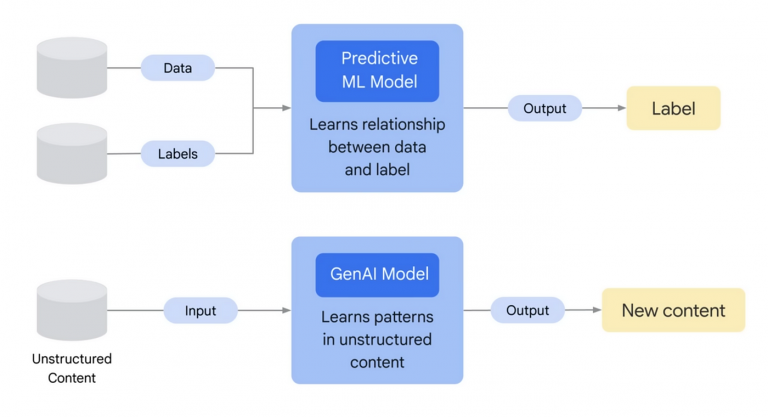What is Generative AI or GenAI?

The technology landscape is more interesting than ever. Only a few innovations in history have generated as much excitement and potential as Generative AI (GenAI). Imagine a world where machines can create new content—whether it’s a captivating piece of music, a stunning visual artwork, or even complex software code—based on patterns and data they’ve learned.
“This is not a scene from a futuristic movie; it’s the reality that GenAI is making possible today.”
At MSBC Group, we are not just spectators of this technological revolution but active participants. We leverage our expertise to help businesses navigate and harness the power of Generative AI. Our commitment to innovation and partnership drives us to demystify complex technologies and make them accessible and beneficial for our clients.
When we talk to business owners and other people about Generative AI, there’s often confusion. Many fail to comprehensively understand GenAI (Generative AI) and tend to confuse it with other forms of artificial intelligence or machine learning technologies. They might mistake it for simple automation tools, basic predictive models, or conventional data analytics. However, Generative AI is distinct in its ability to create new, original content, setting it apart from these other technologies.
Generative AI represents a significant leap forward in artificial intelligence, enabling machines to generate original content that mimics human creativity. This breakthrough technology is built on sophisticated models trained with vast amounts of data, allowing them to understand and reproduce patterns in text, images, audio and more. The implications are profound, offering new avenues for creativity, efficiency and problem-solving across various industries.
In this blog, we will explore what Generative AI is, how it differs from other forms of AI, the mechanics behind its functionality, and its wide-ranging applications. Whether you’re a business leader, a tech enthusiast, or simply curious about the future of AI, this comprehensive guide will provide valuable insights into the transformative world of Generative AI.
Later in this article, we have covered:
- What is GenAI or Generative AI?
- How Does Generative AI Work?
- Generative AI Models – What are ChatGPT, Gemini, DALL-E?
- What is Generative AI Capable Of?
- What kind of problems can be solved by Generative AI?
What is GenAI or Generative AI?
Imagine asking your computer to write a short story or compose a song, and it delivers almost human-made creation. This is the power of Generative AI or GenAI. Artificial intelligence learns from vast amounts of data to create new content, such as text, images, music, and more.
Think of GenAI as a sophisticated tool that can mimic human creativity. Whether it’s generating marketing copy, designing graphics, or even assisting in scientific research, GenAI opens up new possibilities by automating high-quality content creation. Its ability to learn and reproduce patterns from data sets it apart from traditional AI, which primarily focuses on analysing existing data rather than creating new material.
In essence, Generative AI acts as a creative collaborator, helping industries innovate and enhance their productivity by generating fresh, original content based on the patterns it has learned.
How does GenAI work?
Generative AI (GenAI) operates through a process known as deep learning, utilising complex neural networks to understand and replicate patterns found in large datasets. Here’s a step-by-step breakdown of how GenAI works:
- Data Collection:
- Gather vast amounts of data (text, images, etc.).
- Training the Model:
- Feed data into the neural network.
- Use self-supervised learning and backpropagation to train the model.
- Generating New Content:
- Input a prompt into the trained model.
- The model generates new content based on learned patterns.
- Fine-Tuning:
- Adjust the generated content as needed.
- Continue training on specialised datasets for improvement.
Example Application: Suppose you want to generate a paragraph of text. You start by inputting a prompt, such as “The future of AI in healthcare is” into a trained language model. The model uses its learned patterns to complete the sentence, generating a coherent and contextually relevant paragraph about AI in healthcare.

Generative AI Models – What are ChatGPT, Gemini, Dall-E?
Generative AI models have revolutionised how we interact with technology by creating new, original content based on learned patterns from vast datasets. Three notable GenAI models that are widely known are ChatGPT, Gemini, and DALL-E. Let’s understand their capabilities briefly.
- ChatGPT: This model, which introduced GenAI to the public, generates human-like text useful for having conversations, creating content, and completing text prompts.
- Gemini: Made by Google, this model is known for producing high-quality text adaptable to different industries and needs.
- DALL-E: Creates images from text descriptions, making them useful for design and creative projects.
Although these 3 models are widely known, numerous other models, built on these or completely different, are capable of performing many other tasks.
In simple terms, Generative AI models are like smart tools that can create new and innovative content by learning from large amounts of data. They can write, draw, compose, and much more, helping enhance creativity and efficiency in many fields. Let’s take a deeper look at all the things Generative AI is capable of.
What is Generative AI capable of?
Generative AI is a versatile technology with a wide range of capabilities, enabling it to create new and original content across various domains. Here are some of its key capabilities:
- Text Generation: Generative AI can produce coherent and relevant text based on a prompt. This includes writing articles, reports, emails, and even coding scripts. Models such as ChatGPT excel in generating conversational responses and completing text inputs.
- Image Creation: Models such as DALL-E generate images from textual descriptions, making them valuable in design, marketing, and entertainment. For example, describing “a futuristic cityscape at sunset” can create a unique, AI-generated image.
- Music and Audio Production: Generative AI will compose music and generate audio clips, creating new pieces that match specific genres or moods. This is useful for background scores, jingles, and other audio content.
- Video Generation: While developing, Generative AI can create short video clips from text descriptions and enhance video quality, generating higher-resolution versions from lower-quality inputs.
- Code Generation: Generative AI assists in software development by writing and optimising code. Tools such as GitHub Copilot suggest code snippets and complete functions, speeding up development and ensuring code quality.
- Data Augmentation and Synthesis: Generative AI creates synthetic data to augment existing datasets, improving model training in fields like healthcare without compromising privacy.
Generative AI’s ability to generate text, images, music, videos, code, synthetic data, and support scientific research showcases its vast potential to drive innovation and efficiency across various industries.
But what does this mean to me and you? How does it add value to your business? Let’s see what problems it can solve for me and you in everyday life.
What kind of problems can be solved by Generative AI?
Generative AI is a powerful tool that can address various problems across many industries. From creating new content to optimising processes and enhancing innovation, GenAI solves many problems.
Here are some key problems that Generative AI can help solve:
- Customer Service and Support: AI-powered chatbots and virtual assistants provide instant, accurate responses to customer queries, improving service efficiency and satisfaction.
- Financial Analysis and Reporting: It generates detailed financial reports, forecasts trends, and identifies investment opportunities by analysing large datasets quickly and accurately. (Ref: How Voice-AI is changing the banking interactions?)
- Content Creation and Marketing: Generative AI can automate and personalise marketing content, such as blog posts and advertisements.
- Product Design and Development: It assists in creating innovative product designs and prototypes by analysing mock-ups and customer feedback.
- Software Development: Generative AI automates code generation, bug fixing, and optimisation, speeding up the development process and maintaining high code quality.
- Education and Training: AI creates personalised learning materials and simulates complex scenarios, enhancing educational experiences and training programs.
There’s so much more to explore and discuss about Generative AI—how it can specifically help your business, the unique use cases that can be optimised, and the ways it can drive growth and innovation.
If you’re curious about how Generative AI can be tailored to your business needs and want to implement this powerful technology, contact us. Our team at MSBC Group is here to help you harness its full potential.
Stay tuned for more insightful blogs as we explore the world of Generative AI and its endless possibilities.
Transforming Construction Landscape: Synergizing AI, Automation, and Custom Software Solutions
In an era driven by technological advancements, the construction industry is experiencing a transformative phase
The Future of Manufacturing: Leveraging the Power of Custom Software & AI
In the dynamic world of manufacturing, staying ahead of the curve requires embracing technological advancements.
Blockchain for businesses: Real world advancements and application
Blockchain technology is a decentralised digital ledger that records transactions across a network of computers.



